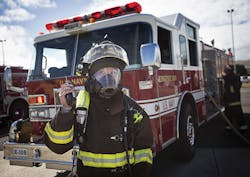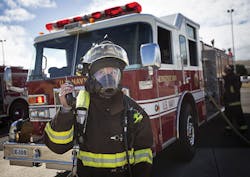By Patrick McLaughlin
The emergence of distributed antenna system (DAS) networks in enterprise environments over the past several years has been driven by the need for users to connect to wireless service provider networks. Whether those users are employees in a corporate environment, guests in venues such as hotels, stadiums and arenas, or travelers in airports and train stations, their ability to send and receive information via mobile devices has become a necessity rather than a luxury. Accordingly, these venues have bolstered their ability to provide connectivity, and many have done so via DAS.
These DAS networks address the connectivity needs of business and personal consumers of wireless services. But these same venues also must be prepared for the potential that in an emergency, first responders will need to be able to communicate with each other on the premises. Currently narrowband systems are common for public safety communication, but ABI Research (www.abiresearch.com) foresees that changing over the next handful of years. The research and analyst firm recently forecast that the evolution to LTE-based public safety from the current narrowband systems will grow at double-digit rates over the next five years, with public safety platforms doubling their spend by 2021. According to ABI’s estimates, the global in-building wireless public safety system business will grow to reach $1.7 billion in revenue in 2021. North America will be the region with the largest spend, ABI said.
The firm’s research director, Nick Marshall, said, “During this transition period, public safety agencies will use LTE in parallel with their legacy narrowband systems. Typically, this will entail agencies relying on TETRA (Terrestrial Trunk Radio) or P25 (Project 25) to supply mission-critical voice and using LTE to supply enhanced data services. Over the next five years, in-building communications systems, such as DAS, will be used to distribute public safety coverage and capacity in buildings.”
Current technology
TETRA digital trunked mobile radio standard was developed by the European Telecommunications Standards Institute, ETSI. The organization says the standard “has been specifically developed to meet the needs of a variety of traditional professional mobile radio user organizations.” Additionally, the TETRA standard “has been developed to meet the needs of public access mobile radio operators,” ETSI explains. “To meet the ever-changing user requirements and utilize the latest in technology developments, TETRA continues to be evolved and enhanced with the development of new standards. An example of this is TETRA Release 2, which includes the TETRA Enhanced Data Service that provides wideband high-speed data communication service.”
According to the Project 25 Interest Group (www.project25.org), P25 “is the standard for the design and manufacture of interoperable digital two-way wireless communications products. Developed in North America with state, local and federal representatives and Telecommunications Industry Association (TIA) governance, P25 has gained worldwide acceptance for public safety, security, public service, and commercial applications.”
In its recent analysis, ABI commented that evolution to wideband public safety networks and platforms “will be given a major boost by the 3GPP’s [mobile broadband standard’s] upcoming LTE Advanced Pro specification due to be finalized in 2016. Government organizations like the US’s FirstNet and the UK’s Emergency Services Network [ESN] are all poised to start nationwide public safety network buildouts. Other regions and countries, including South Korea and China, all have similar plans to migrate to broadband for public safety.”
ABI’s Marshall noted, “Indoor public safety networks are more stringently specified than commercial indoor networks and must respond to the public safety imperatives of high availability and reliability. Public safety communications must also be made available in areas not traditionally covered by commercial cellular communications such as stair wells, equipment rooms and underground locations.”
Infrastructure observations
Structured low-voltage cabling-system design and installation firm Corporate Technology Solutions (CTS; www.ctscabling.com) addressed the topic of public-safety DAS infrastructure in a post on its blog. The post reads, in part, “Distributed antenna systems offer venues a way to provide safety and security measures, enabling first responders to have quick, clear radio communication within any given space. Using distributed antenna systems, a public safety network can be deployed within a building or other venue. Distributed antenna systems increase and extend mobile coverage and capacity ensuring there are no dead zones within a venue that would prohibit first responders from doing their jobs.
“Redundancy is important within a public safety network, which is different from your typical commercial distributed antenna systems network design. For public safety reasons, you also need to consider how to defeat interference and integrate handset power control and coverage standards into your network design.”
CTS adds that it’s often wise to separate a public safety network from a public or commercial DAS, “as each system may have vastly different requirements for network design. Trying to combine the two can lead to unnecessary costs and complications. Also, you want to have your public safety network fully accessible to emergency workers-something that becomes complex if there are public or commercial users on the system. This means the infrastructure itself should be different and separate, within maintenance and user access strictly controlled so there is no unwanted crossover.”
Recently Corning incorporated Fiber-Span Inc.’s public safety DAS as part of Corning’s Optical Network Evolution (ONE) platform. “Fiber-Span’s public safety DAS is a comprehensive fiber-optic wireless solution for police, fire, emergency, first responder and Homeland Security radio system applications,” Corning said when announcing the addition to its platform.
“The technology delivers clear, clean and distortion-free transmission and distribution of critical communication information, including wireless voice, data, and video,” Corning added. “It supports all public safety bands, including VHF/UHF/700/800/900/TETRA, and meets International Fire Code and National Fire Protection Agency requirements.
“When deployed together, Fiber-Span’s public safety DAS can leverage ONE’s fiber backbone to set up a separate, parallel antenna system that differentiates authority of network operation, maintenance and alarm/monitoring service; and enables network design flexibility, while reducing the cost of overall deployment.”
Mike O’Day is Corning’s vice president for wireless networks. He commented, “The Corning ONE converged infrastructure leverages dedicated fibers for voice, video, data and unlimited applications-like public safety-all in one composite cable that supports nearly every connectivity need. This flexible, scalable design strategy enables the delivery of secure, cost-effective, and efficient public safety coverage, without sacrificing the performance of any other network applications.”
FirstNet’s implications
The FirstNet initiative that ABI Research pointed to as a driver of change in the coming years, is a literal result of an act of Congress. As described on the FirstNet website, www.firstnet.gov, “Signed into law on February 22, 2012, the Middle Class Tax Relief and Job Creation Act created the First Responder Network Authority (FirstNet). The law gives FirstNet the mission to build, operate and maintain the first high-speed nationwide wireless broadband network dedicated to public safety. FirstNet will provide a single interoperable platform for emergency and daily public safety communications.
“This broadband network will fulfill a fundamental need of the public safety community as well as the last remaining recommendation of the 9/11 Commission. FirstNet will bring 21st-centry tools to tens of thousands of organizations and individuals that respond to emergencies at the local, state, tribal and federal levels … Using nationwide 700-MHz spectrum, FirstNet will put an end to decades-long interoperability and communications challenges …”
FirstNet is an independent authority within the U.S. Department of Commerce’s National Telecommunications and Information Administration. The 2012 legislation allocated the spectrum as well as up to $7 billion in funding to construct the FirstNet network. All 56 U.S. states and territories must have a radio access network that is connected to the FirstNet core network in order for it to be truly nationwide, as it purports it will be. “To contain costs, FirstNet is tasked with leveraging existing telecommunications infrastructure and assets,” the authority said. “This includes exploring public/private partnerships that can help support and accelerate the creation of this new advanced wireless network.”
In January FirstNet issued its request for proposals (RFP). At that time, FirstNet chief executive officer Mike Poth commented, “We have developed this RFP in an open forum to create a first-of-its-kind public-private partnership for the network. As we move into the next phase of the process, we look forward to receiving competitive offerings to deliver the best possible network for public safety.” The RFP was issued after what FirstNet characterized as “more than a year of dialogue with public safety and industry on the objectives and scope” of the RFP. “The buildup to the release has included 13 requests for information, a set of draft RFP documents, two industry-day public events, answers to more than 650 questions related to network specifications, and meetings with interested vendors.”
In February, the authority said it released a set of answers to more than 400 questions it received on its RFP. Since that time, FirstNet extended its deadline for final proposals to May 31.
Speaking at the 2016 International Wireless Communications Expo (IWCE), FirstNet’s director of program management James Mitchell provided some details of how the bidding process will shape up after the May 31 deadline. In late April, Donny Jackson reported in IWCE’s Urgent Communications, “After receiving bids from offerors, FirstNet evaluators will engage in a lengthy, negotiation-filled process in an effort to forge the best arrangement with its contractor on behalf of public-safety users.”
Jackson further quoted Mitchell from Mitchell’s IWCE address, as follows, “Price, in your typical contract, is what we’re going to pay industry to do something. That’s flipped here. Our partner, or contractor, will be paying us for access to the spectrum, and there will be an exchange, based on the adoption targets that are presented in the proposal process and thereby agreed to in a contract … I’m not asking for the lowest-cost, technically acceptable, requirements-based acquisition. I want more stuff for public safety. I want a better network. I want to go bigger, faster and stronger than previous offerings, and I’m actually asking industry to pay us to make that happen. That’s an awkward proposition, but it’s one that we’ve laid out in Section B of the RFP.”
IWCE Urgent Communications’ Jackson also reported that each offeror will propose its own public-safety adoption targets for states and territories, and each offeror “will play a key role in defining who qualifies as a public-safety entity that is eligible for prioritized service on the network. FirstNet’s RFP specifies that police, fire and EMS personnel will be the ‘primary user group,’ but the FirstNet contractor will be asked to determine who should be included in the ‘extended primary user group.’”
In a blog post dated April 18, FirstNet’s CEO Poth noted, “FirstNet has and will continue to take steps to ensure the longevity and relevance of the NPSBN [Nationwide Public Safety Broadband Network] for the public safety community. For example, with renewals, the term of the agreement resulting from the NPSBN RFP is anticipated to be up to 25 years, which will allow the awardee to confidently invest in the network and in the provision of services to the public safety community, while also serving its commercial users with excess network capacity. Market forces will undoubtedly self-mandate continued awardee investment and upgrades in the network, including implementation of 3GPP standards and other standards as they develop and advance throughout the life of the network.
“In addition, under the Act, FirstNet is able to collect amounts to advance or enhance public safety communications, while certain resources allocated by FirstNet, such as fees collected under the agreement with the NPSBN awardee in excess of FirstNet’s overhead costs, are specifically earmarked under the Act for ‘constructing, maintaining, operating, or improving’ the NPSBN.”
Jackson reported that the May 31 RFP deadline is likely to be the beginning of a negotiation process for whichever bidder FirstNet selects. The dynamics of U.S. states and territories buying into, or opting out of, FirstNet will shape the entire program. FirstNet is likely to put public safety DAS on the radar for network owners and service providers in the years ahead.
Patrick McLaughlin is our chief editor.


